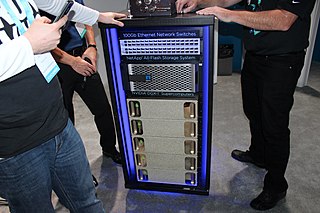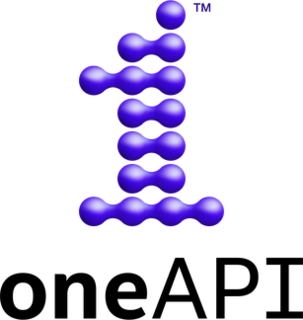Related Research Articles

Nvidia Corporation, commonly known as Nvidia, is an American multinational technology company incorporated in Delaware and based in Santa Clara, California. It is a software and fabless company which designs graphics processing units (GPUs), application programming interface (APIs) for data science and high-performance computing as well as system on a chip units (SoCs) for the mobile computing and automotive market. Nvidia is a global leader in artificial intelligence hardware and software. Its professional line of GPUs are used in workstations for applications in such fields as architecture, engineering and construction, media and entertainment, automotive, scientific research, and manufacturing design.

David A. Bader is a Distinguished Professor and Director of the Institute for Data Science at the New Jersey Institute of Technology. Previously, he served as the Chair of the Georgia Institute of Technology School of Computational Science & Engineering, where he was also a founding professor, and the executive director of High-Performance Computing at the Georgia Tech College of Computing. In 2007, he was named the first director of the Sony Toshiba IBM Center of Competence for the Cell Processor at Georgia Tech. Bader has served on the Computing Research Association's Board of Directors, the National Science Foundation's Advisory Committee on Cyberinfrastructure, and on the IEEE Computer Society's Board of Governors. He is an expert in the design and analysis of parallel and multicore algorithms for real-world applications such as those in cybersecurity and computational biology. His main areas of research are at the intersection of high-performance computing and real-world applications, including cybersecurity, massive-scale analytics, and computational genomics. Bader built the first Linux supercomputer using commodity processors and a high-speed interconnection network.
The Pittsburgh Supercomputing Center (PSC) is a high performance computing and networking center founded in 1986 and one of the original five NSF Supercomputing Centers. PSC is a joint effort of Carnegie Mellon University and the University of Pittsburgh in Pittsburgh, Pennsylvania, United States.

The TOP500 project ranks and details the 500 most powerful non-distributed computer systems in the world. The project was started in 1993 and publishes an updated list of the supercomputers twice a year. The first of these updates always coincides with the International Supercomputing Conference in June, and the second is presented at the ACM/IEEE Supercomputing Conference in November. The project aims to provide a reliable basis for tracking and detecting trends in high-performance computing and bases rankings on HPL, a portable implementation of the high-performance LINPACK benchmark written in Fortran for distributed-memory computers.
A personal supercomputer (PSC) is a marketing ploy used by computer manufacturers for high-performance computer systems and was a popular term in the mid 2000s to early 2010s. There is no exact definition for what a personal supercomputer is. Many systems have had that label put on them like the Cray CX1 and the Apple Power Mac G4. Generally, though the label is used on computers that are High end Workstations and Servers and have multiple processors and is small enough to fit on a desk or to the side. Other terms like PSC are Desktop/deskside supercomputers and supercomputers in a box.
The Green500 is a biannual ranking of supercomputers, from the TOP500 list of supercomputers, in terms of energy efficiency. The list measures performance per watt using the TOP500 measure of high performance LINPACK benchmarks at double-precision floating-point format.
This list compares various amounts of computing power in instructions per second organized by order of magnitude in FLOPS.
SAGA-220 is a supercomputer built by the Indian Space Research Organisation (ISRO).

Tsubame is a series of supercomputers that operates at the GSIC Center at the Tokyo Institute of Technology in Japan, designed by Satoshi Matsuoka.
Volta is the codename for a GPU microarchitecture developed by Nvidia, succeeding Pascal. It was first announced on a roadmap in March 2013, although the first product was not announced until May 2017. The architecture is named after 18th–19th century Italian chemist and physicist Alessandro Volta. It was NVIDIA's first chip to feature Tensor Cores, specially designed cores that have superior deep learning performance over regular CUDA cores. The architecture is produced with TSMC's 12 nm FinFET process. The Ampere microarchitecture is the successor to Volta.

Summit or OLCF-4 is a supercomputer developed by IBM for use at Oak Ridge Leadership Computing Facility (OLCF), a facility at the Oak Ridge National Laboratory, capable of 200 petaFLOPS thus making it the 4th fastest supercomputer in the world after Frontier (OLCF-5), Fugaku, and LUMI. It held the number 1 position from November 2018 to June 2020. Its current LINPACK benchmark is clocked at 148.6 petaFLOPS.

Nvidia DGX is a line of NVIDIA-produced servers and workstations which specialize in using GPGPU to accelerate deep learning applications. The typical design of a DGX system is based upon a rackmount chassis with motherboard that carries high performance x86 server CPUs. The main component of a DGX system is a set of 4 to 16 Nvidia Tesla GPU modules on an independent system board, DGX systems have large heatsinks and powerful fans to adequately cool thousands of watts of thermal output. The GPU modules are typically integrated into the system using a version of the SXM socket.
Ampere is the codename for a graphics processing unit (GPU) microarchitecture developed by Nvidia as the successor to both the Volta and Turing architectures, officially announced on May 14, 2020. It is named after French mathematician and physicist André-Marie Ampère. Nvidia announced the next-generation GeForce 30 series consumer GPUs at a GeForce Special Event on September 1, 2020. Nvidia announced A100 80GB GPU at SC20 on November 16, 2020. Mobile RTX graphics cards and the RTX 3060 were revealed on January 12, 2021. Nvidia also announced Ampere's successor, Hopper, at GTC 2022, and "Ampere Next Next" for a 2024 release at GPU Technology Conference 2021.

oneAPI is an open standard for a unified application programming interface intended to be used across different compute accelerator (coprocessor) architectures, including GPUs, AI accelerators and field-programmable gate arrays. It is intended to eliminate the need for developers to maintain separate code bases, multiple programming languages, and different tools and workflows for each architecture.

Christofari — are Christofari (2019), Christofari Neo (2021) supercomputers of Sberbank based on Nvidia corporation hardware Sberbank of Russia and Nvidia. Their main purpose is neural network learning. They are also used for scientific research and commercial calculations.

Cerebras Systems is an American artificial intelligence company with offices in Sunnyvale and San Diego, California, Toronto, Tokyo and Bangalore, India. Cerebras builds computer systems for complex artificial intelligence deep learning applications.
NVIDIA GTC is a global AI conference for developers that brings together developers, engineers, researchers, inventors, and IT professionals. Topics focus on artificial intelligence (AI), computer graphics, data science, machine learning and autonomous machines. Each conference begins with a keynote from Nvidia CEO and Founder Jensen Huang, followed by a variety of sessions and talks with experts from around the world.
JUWELS is a supercomputer developed by Atos Forschungszentrum Jülich, capable of 70.980 petaflops. It replaced the now disused JUQUEEN supercomputer. JUWELS Booster Module is ranked as the eight fastest supercomputer in the world. The JUWELS Booster Module is part of a modular system architecture and a second Xeon based JUWELS Module ranks separately as the 52nd fastest supercomputer in the world.
Leonardo is a petascale supercomputer currently under construction at the CINECA datacenter in Bologna, Italy. The system consists of an Atos BullSequana XH2000 computer, with close to 14,000 Nvidia Ampere GPUs and 200Gb/s Nvidia Mellanox HDR InfiniBand connectivity. Once completed, Leonardo will be capable of 250 petaflops, which will make it one of the top five fastest supercomputers in the world. Leonardo's components arrived on site in July 2022, and it is scheduled to begin operations by the end of summer 2022.
HPC5 is a supercomputer built by Dell and installed by Eni, capable of 51.721 petaflops, and is ranked 9th in the Top500 as of November 2021. It is located in the Green Data Center in Ferrera Erbognone, in Northern Italy. In June 2020, HPC5 ranked 6th in the Green500. HPC5 is an upgrade to the HPC4 system, which was built by Hewlett Packard Enterprise and used by Eni. It is also called as HPC4+.
References
- ↑ "Top500: Fugaku Keeps Crown, Nvidia's Selene Climbs to #5". HPCwire. 2020-11-16. Retrieved 2021-06-17.
- ↑ Kobie, Nicole. "NVIDIA and the battle for the future of AI chips". Wired . ISSN 1357-0978 . Retrieved 2021-06-17.
- 1 2 Strategy, Moor Insights and. "NVIDIA Provides More Details On Selene Supercomputer". Forbes . Retrieved 2021-06-17.
{{cite web}}: CS1 maint: url-status (link) - ↑ Freund, Karl. "NVIDIA Continues To Evolve, From Chips To Software To AI Data Centers". Forbes . Retrieved 2021-06-17.
{{cite web}}: CS1 maint: url-status (link) - ↑ "Nvidia Nabs #7 Spot on Top500 with Selene, Launches A100 PCIe Cards". HPCwire. 2020-06-22. Retrieved 2021-09-28.
- ↑ Jarred Walton (2022-03-22). "Nvidia Reveals Hopper H100 GPU With 80 Billion Transistors". Tom's Hardware . Retrieved 2022-04-05.
- ↑ "How realistic is Graphcore's 2024 timeline for ultra-intelligent supercomputers". Analytics India Magazine. 2022-03-16. Retrieved 2022-04-14.
- ↑ "AI Weekly: AI supercomputers and facial recognition to verify taxpayers' identities". VentureBeat . 2022-01-28. Retrieved 2022-02-07.
- ↑ Dorrier, Jason (2022-01-26). "Meta Is Making a Monster AI Supercomputer for the Metaverse". Singularity Hub. Retrieved 2022-02-07.
- ↑ "NVIDIA: MLPerf AI Benchmarks". NVIDIA . Retrieved 2021-12-13.
{{cite web}}: CS1 maint: url-status (link) - ↑ "Is AI Training Outstripping Moore's Law?". IEEE Spectrum . 2021-12-02. Retrieved 2021-12-13.
{{cite web}}: CS1 maint: url-status (link) - ↑ "Nvidia Built Its Selene Supercomputer for Coronavirus Research in Just Three Weeks (Silicon Angle)". Informatics Institute. 2020-08-17. Retrieved 2021-12-13.
- ↑ "Nvidia built its Selene supercomputer for coronavirus research in just 3 weeks". SiliconANGLE. 2020-08-14. Retrieved 2021-12-13.
- ↑ "NVIDIA Canvas : Harness The Power Of AI". NVIDIA . Retrieved 2022-01-10.
{{cite web}}: CS1 maint: url-status (link) - ↑ Katie Wickens (2022-01-06). "Nvidia's upgraded AI art tool turned my obscure squiggles into a masterpiece". PC Gamer . Retrieved 2022-01-10.
- ↑ Applications (2022-01-05). "Nvidia Canvas uses GauGAN2 AI model to achieve 4x resolution boost". AI News. Retrieved 2022-01-10.